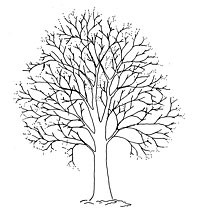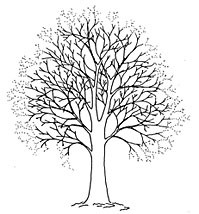Tree Pruning
 Crown Thin
Crown Thin
Crown thinning is the removal of a portion of smaller/tertiary branches, usually at the outer crown, to produce a uniform density of foliage around an evenly spaced branch structure. It is usually confined to broad-leaved species. Crown thinning does not alter the overall size or shape of the tree. Material should be removed systematically throughout the tree, should not exceed the stated percentage and not more than 30% overall. Common reasons for crown thinning are to allow more light to pass through the tree, reduce wind resistance, reduce weight (but this does not necessarily reduce leverage on the structure) and is rarely a once-only operation particularly on species that are known to produce large amounts of epicormic growth.

Crown Lift or Crown Raising
Crown lifting is the removal of the lowest branches and/or preparing of lower branches for future removal. Good practice dictates crown lifting should not normally include the removal of large branches growing directly from the trunk as this can cause large wounds which can become extensively decayed leading to further long term problems or more short term biomechanical instability. Crown lifting on older, mature trees should be avoided or restricted to secondary branches or shortening of primary branches rather than the whole removal wherever possible. Crown lifting is an effective method of increasing light transmission to areas closer to the tree or to enable access under the crown but should be restricted to less than 15% of the live crown height and leave the crown at least two thirds of the total height of the tree. Crown lifting should be specified with reference to a fixed point, e.g. ‘crown lift to give 5.5m clearance above ground level’.
 Crown Reduction
Crown Reduction
The reduction in height and/or spread of the crown (the foliage bearing portions) of a tree. Crown reduction may be used to reduce mechanical stress on individual branches or the whole tree, make the tree more suited to its immediate environment or to reduce the effects of shading and light loss, etc. The final result should retain the main framework of the crown, and so a significant proportion of the leaf bearing structure, and leave a similar, although smaller outline, and not necessarily achieve symmetry for its own sake. Crown reduction cuts should be as small as possible and in general not exceed 100mm diameter unless there is an overriding need to do so. Reductions should be specified by actual measurements, where possible, and reflect the finished result, but may also refer to lengths of parts to be removed to aid clarity, e.g. ‘crown reduce in height by 2.0m and lateral spread by 1.0m, all round, to finished crown dimensions of 18m in height by 11m in spread (all measurements approximate.)’. Not all species are suitable for this treatment and crown reduction should not be confused with ‘topping’, an indiscriminate and harmful treatment.
Tree Felling/Dismantling.
Sometimes it is necessary to completely remove a tree or trees, this can be due to them posing a health and safety hazard or that they need to be removed to make way for development. We are highly skilled in both felling trees from ground level where space allows or climbing and dismantling them using the latest rigging techniques if space is limited or there are items under the tree which must not be damaged.
Site Clearance.
If you need a contractor to clear an area of trees and vegetation to make way for a new building or infrastructure project we are more than capable of meeting your requirements. We are CHAS accredited and all our operatives are CSCS qualified, as well as holding the relevant NPTC certificates for the tasks they are assigned to undertake meaning you can rest assured that we will meet your compliance needs with minimum fuss.
Grounds Maintenance
If you have a site that requires regular grounds maintenance be that grass cutting, pruning or regular flower bed maintenance, get in touch. We are well established in this field and have a team dedicated to this task.
Deadwood Removal.
It is not uncommon for mature trees to have dead branches in their crowns along with small broke sections or crossing limbs. These can be removed with relative ease by one of our competent climbers, it is especially important to carry out this work if the tree crown is over areas of pedestrian or vehicular traffic or simply over buildings which could be damaged by falling pieces of timber or limbs.
24 Hour Emergency Callout.
We are available 24 hours a day to deal with trees which fail due to natural causes or through storm damage and need to be made safe at the earliest opportunity. We can offer this service for a callout fee of £70 which includes the first hours work (for a two man team with van and six inch tracked woodchipper) and then an hourly rate there after depending on the equipment and size of team requested. In times of forecast high winds we keep a two man team on standby ready to deploy across South Yorkshire.

